VTS India Incorporating Guidelines for preventing COVID-19 spread
The Ministry of Health and Family Welfare, Government of India, WHO, other National and Local Health bodies along with the media have constantly been informing people to protect themselves by practicing social distancing, washing hands regularly with soap and water for at least 20 seconds or using alcohol containing disinfectant (at least 60%), and wearing a mask.
For the conditions having multiple occupancies with the highest footfall rate like Commercial and Industrial establishments, healthcare facilities, educational instructions and many more necessary precautions to be considered for the proper operation of air conditioning and ventilation system with proper maintenance of temperate and relative humidity level in any indoor spaces.
HVAC is one kind of system used to provide comfortable indoor environmental conditions by addressing humidity & temperature control in any indoor spaces. The HVAC systems can be configured in any way, depending on the application. One such feature of the HVAC system allowing this is Air Handling Units, which can be configured to reduce the spread of COVID-19.
Following various operating guidelines proposed by scientific bodies, VTS is following and implementing these procedures with Air Handling Units.
UVC lights - considering the use of electromagnetic radiation in the airflow path commonly known as UVGI fixtures. Ultraviolet germicidal irradiation (UVGI) uses ultraviolet (UV) energy (electromagnetic radiation with a wavelength shorter than that of visible light) to kill or inactive viral, bacterial, fungal species. Although UVC is invisible to the human eye, a small amount of energy released at visible wavelengths produces the blue glow emitted by UVC lamps.
This UVGI fixture can be installed for larger ducted units and AHUs to keep coils continuously clean and disinfected.
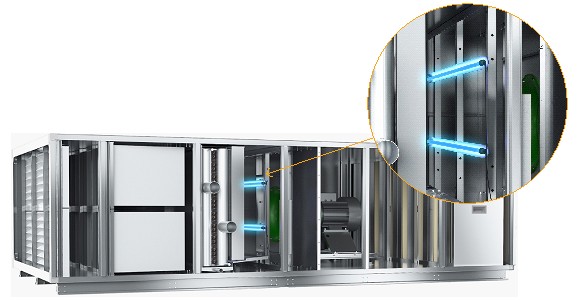
Representation of Air Handling Units setup with Filter and UVGI fixture
HEPA filters - with the encouragement to improve the filter efficiency in the HVAC system, the use of Mechanical filters having the filter capacity level MERV 13 or higher (MERV - Minimum Efficiency Reporting Value) is recommended. The higher the MERV number, the better the ability of a filter to remove the particles from the air ranging in sizes from 0.3 to 10 microns in diameter at standard airflow rate. ASHRAE recommends that mechanical filter efficiency be at least MERV 13 and preferable MERV 14 or better to help mitigate the infectious aerosols' transmission.
Utmost care must be considered while increasing the filter efficiency in an HVAC system Follow the HVAC system capacity like fan and motor capacity, making sure it's sufficient to accommodate the better filters without adversely affecting the system's ability to maintain the required indoor temperature/humidity conditions and space pressure relationships.
High efficient particulate air (HEPA) filters are more efficient then MERV 16 filters. For the proper functioning, HEPA filters must be sealed properly in filter racks which require careful handling to prevent damage and preserve performance.
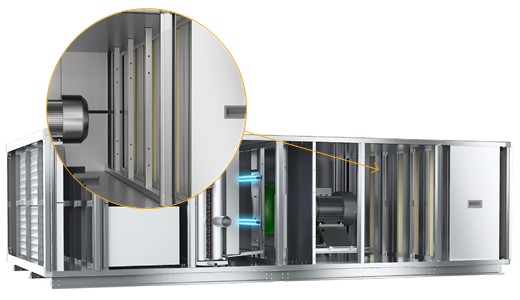
Overall efficiency in reducing the particle concentration depends on many factors like:
- Filter efficiency
- Airflow rate through the filter
- Particle size
Filter location in the HVAC system.
For efficient operation and management HVAC systems below, the following general guidelines are suggested and practiced.
- Variation in the relative humidity (RH) and temperature results in formations of the mucus membrane. Some virus transmission may occur, studies indicate that 80% relative humidity and above tend to neutralize the COVID-19 virus. However, too much humidity leads to higher levels of dust mites and fungi, two of the worst culprits for indoor allergy sufferers. Mold and fungi are known to exacerbate respiratory conditions such as asthma. Considering all the factors, the relative humidity level of 40% ~ 70% is regarded to be the most suitable environment for humans & decreases pathogens' problems.
- Studies conducted at various RH levels have shown that using viral culture methods low temperatures (7–8 ° C) was optimal for airborne influenza survival, with virus survival decreasing progressively at moderate temperatures (20.5– 24 ° C) and further decreases at higher ( greater than 30 ° C) temperatures.
- A minimum fresh air volume of 8.5 m 3 / hour per person and 1.1 m 3 / hour per sq m (5 CFM per person and 0.06 CFM per sq ft) is recommended. The recommendation is to maximize the supply of outside air within the limits of the system.
- It is advisable to inspect the AHUs and ducts for airtightness and low leakage at the installation time.
- Check for particulate accumulation on filters and replace them as needed; filters should be changed with the system turned off while wearing gloves and respiratory track protection. The used filter should be disposed of in sealed bags.
- Check the control system and devices for evidence of improper operation.
- Check variable-frequency drive for proper operation.
- Extended operation times are recommended for buildings with mechanical ventilation systems. Adjust the clock times of system timers to start ventilation at the nominal speed at least 2 hours before the building opening time and switch to a lower rate 2 hours after the building usage time.
- Keep the ventilation running 24/7, with lower (but not switched off) ventilation rates when people are absent. During unoccupied periods, the ventilation may be operated periodically to maintain the minimum outdoor airflow rate.
Below are some of the COVID-19 prevention projects done by VTS India with the help of Eurovent-certified Air Handling Units.
» Vevra Pods, AI-driven movable hospitals
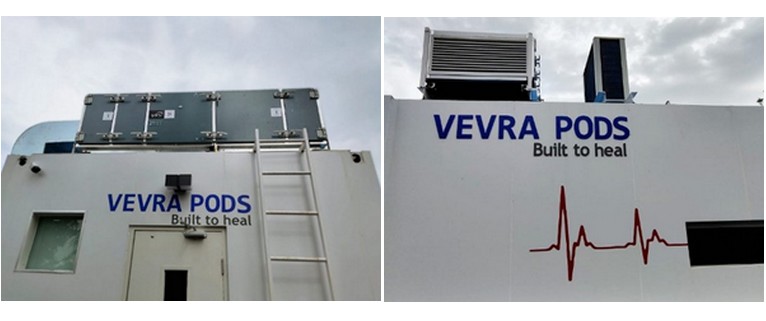
» BBMP Super Specialty hospital
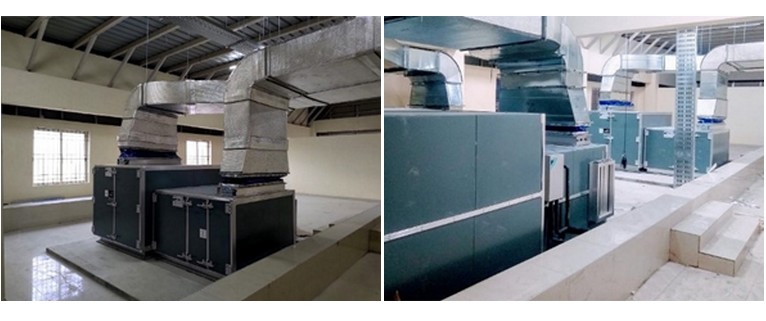
» Navi Mumbai Municipal Corporation's (NMMC)
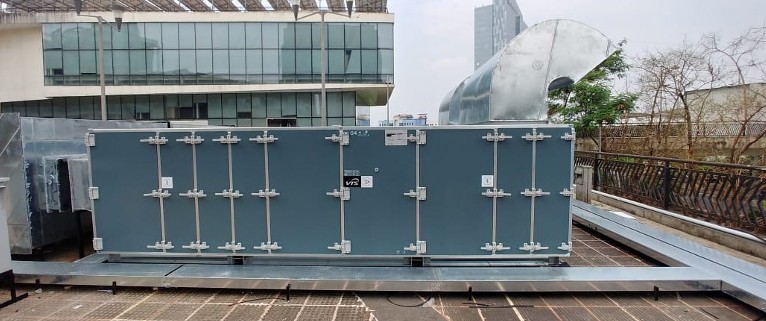
Original Source
[1] ISHRAE Position Document on COVID-19 Guidance for Air Conditioning and Ventilation, p6-9
[2] ASHRAE Position Document on Guidance for Re-Opening Buildings
[3] ASHRAE Position Document Pandemic COVID-19 and Airborne Transmission
[4] Coronavirus disease (COVID-19) advice for the public by WHO
[5] ASHRAE EPIDEMIC TASK FORCE FILTRATION & DISINFECTION, Section - Ultraviolet energy (UV-C) and Air Filtration
 English
English Polski
Polski Germany
Germany LATAM
LATAM Bulgaria
Bulgaria Estonia
Estonia France
France Hungary
Hungary India
India Italy
Italy Kazakhstan
Kazakhstan Romania
Romania Czech Republic
Czech Republic Ukraine
Ukraine United Arab Emirates
United Arab Emirates Latvia
Latvia Lithuania
Lithuania United States of America
United States of America
 Turkey
Turkey